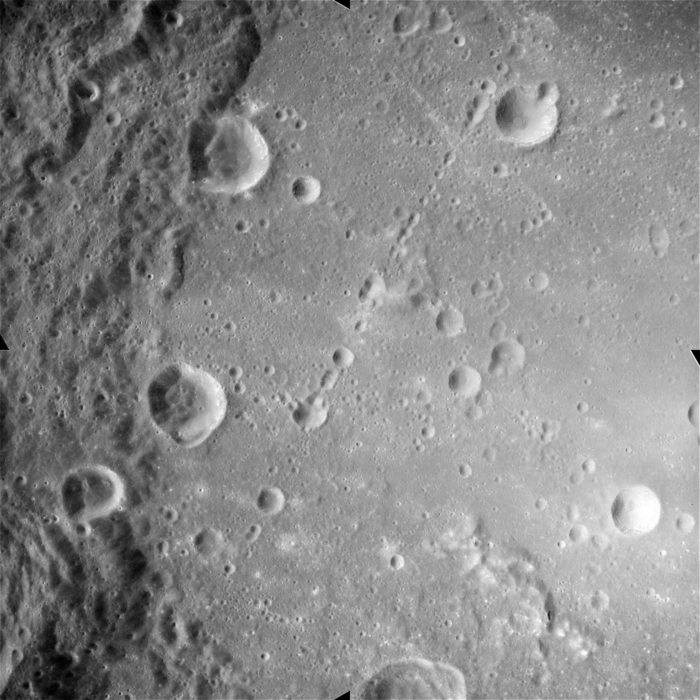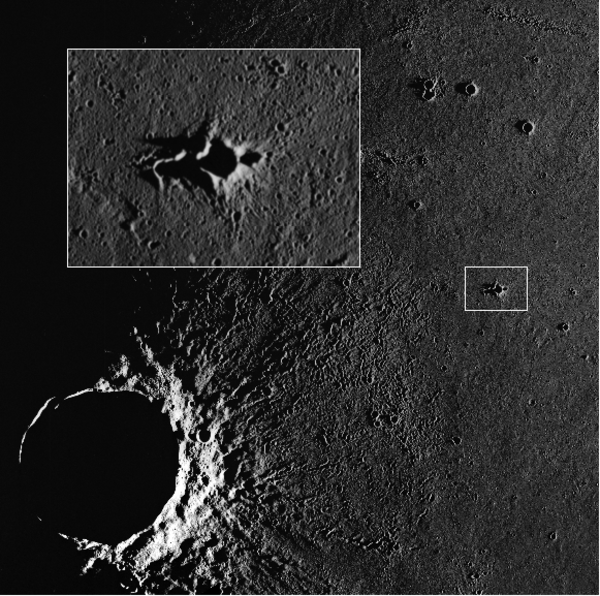
| Project Home | About the Scans | Browse Gallery | Image Map | Support Data | Resources | Ephemeris |
Featured Image - 12/2/2008
Crater Chain in Mendeleev
Catena Mendeleev is a linear crater chain probably formed by the
impact of fragments (called 'secondaries' by planetary scientists)
that were ejected by the impact that formed Tsiolkovsky
Crater, which is 850 kilometers to the southwest of Mendeleev.
Crater chains formed from secondary impacts are radial to their
parent crater. Secondary craters in a chain are usually elongate in
shape, with irregular rims and a 'splashed' appearance of the ejecta.
Sometimes secondaries form 'herringbone ridges,' which are often
difficult to see in images taken at high sun angles. Secondary crater
chains tend to occur in a zone immediately surrounding a large
primary crater, like the chain in Figure 2. However, larger impacts
can move significant amounts of ejecta, including crater chains, far
from the primary crater.
Other crater chains are thought to be volcanic in origin. With the
volcanic variety, the craters are lined up along a common fault or
set of faults, and each crater produces a blanket of volcanic
ejecta. Volcanic crater chains are not assocated with a parent
crater. Occasionally it is difficult to differentiate between the two
types of crater chains. Only further imagery of the lunar
surface, like the high-resolution images that will be collected by
the Lunar Reconnaissance Orbiter
Camera will help us correctly distinguish volcanic and impact
crater chain features.
Figure 1. The smooth floor of Mendeleev includes many craters and is approximately 4.2 to 4.3 billion years old, as shown by crater counts. Mendeleev is ~313 kilometers in diameter. Catena Mendeleev is the linear crater chain stretching NE to SW across crater Mendeleev. Terracing of the crater wall is visible in the upper left hand corner. Sun elevation is 41.0 degrees. (Apollo Image AS16-M-0063 [NASA/JSC/Arizona State University])
Figure 2. The crater Euler, which is about 40 kilometers in diameter, has an ejecta blanket which contains textbook examples of impact crater chains. The inset shows a magnified view of the irregular shape and V-shaped ridges. Sun elevation is 0.0 degrees. (Apollo Image AS15-M-1159 [NASA/JSC/Arizona State University])
Sources:
Apollo Over the Moon: A View From Orbit (1978) H. Masursky, G.W. Colton, F. El-Baz, eds. NASA Sp-362. http://www.hq.nasa.gov/office/pao/History/SP-362/contents.htm
Laboratory Simulation of the Herringbone Pattern Associated with Lunar Secondary Crater Chains (1974) V.R. Oberbeck and H.R. Morrison. The Moon. D. Reidel Publishing Company, Dordrecht-Holland.

|
|
Space Exploration Resources |
|
 LPI LPI
|

